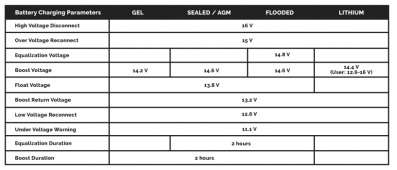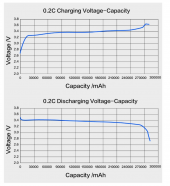thegoogler
New Member
- Joined
- Apr 15, 2021
- Messages
- 108
Hi folks,
New-ish guy here. I've been doing SLA and solar on my trailer for year, but I've been reading a lot of the forum posts for the last couple months and started posting recently. I finished building my LiFePO4 battery bank over the weekend, and in an effort to (over)optimize my setup I wanted to pose a couple questions to those who are smarter and far more experienced with LFP than me.
My 12V setup is 4x 271Ah CATL cells (LiitoKala "280Ah") with a pseudo-overkill solar BMS (only because overkill was out of stock). I have a Renogy Rover Elite charge controller which handles two fixed 175W solar panels plus a portable 100W panel (so 450W max).
Question 1: I've read Will's recommendations, but I'm still confused. As part of top-balancing I pushed all the cells to between 3.630 and 3.637V. After sitting for a night they were roughly 3.52V. So which is 100%... 14.5V (max I can charge to) or 14.1V (where they eventually settle at)?
Question 2: If I want to max out my battery at ~90% SOC, what should I set the charge controller to? (Note: Renogy's default is 14.4V and it's adjustable but annoyingly only in 0.2V increments... more on this below). If I run a load and drain off 28Ah, then turn everything off and record the voltage (not sure what that is yet but let's assume for discussion purposes it's 3.4V per cell/13.6V total), is that voltage reasonably accurate for 90%? Asking since I know adding a load or a charge will vary the voltage and since I have solar panels and always at least a nominal ~0.3A load the battery will never be "idle".
Question 3: If (hypothetically) 13.6V is 90%, should I set my solar controller to 13.6V? Or should it be slightly higher to ensure it gets a full charge? It seems like the ideal charging profile would allow the solar controller to charge at 14.4V, but would cut off charging when I hit 90%/13.6V; however my Renogy doesn't support that.
Question 4: Is there a better reasonably priced charge controller I should use that is significantly more configurable? I'm not against spending ~$350 for something like the Victron MPPT 100/50, or something similar, but I only really want to spend the $ if it's going to provide a significant improvement in charging performance (meaning "speed at which it gets the battery to 90% and/or a meaningful increase in battery life). TBH I don't love my Renogy controller, but it's working and so it's hard for me to spend several hundred $ on a different for a marginal improvement... if I'm dropping the coin I have to justify it as a big improvement.
Last thing, I have a few notes about my setup:

New-ish guy here. I've been doing SLA and solar on my trailer for year, but I've been reading a lot of the forum posts for the last couple months and started posting recently. I finished building my LiFePO4 battery bank over the weekend, and in an effort to (over)optimize my setup I wanted to pose a couple questions to those who are smarter and far more experienced with LFP than me.
My 12V setup is 4x 271Ah CATL cells (LiitoKala "280Ah") with a pseudo-overkill solar BMS (only because overkill was out of stock). I have a Renogy Rover Elite charge controller which handles two fixed 175W solar panels plus a portable 100W panel (so 450W max).
Question 1: I've read Will's recommendations, but I'm still confused. As part of top-balancing I pushed all the cells to between 3.630 and 3.637V. After sitting for a night they were roughly 3.52V. So which is 100%... 14.5V (max I can charge to) or 14.1V (where they eventually settle at)?
Question 2: If I want to max out my battery at ~90% SOC, what should I set the charge controller to? (Note: Renogy's default is 14.4V and it's adjustable but annoyingly only in 0.2V increments... more on this below). If I run a load and drain off 28Ah, then turn everything off and record the voltage (not sure what that is yet but let's assume for discussion purposes it's 3.4V per cell/13.6V total), is that voltage reasonably accurate for 90%? Asking since I know adding a load or a charge will vary the voltage and since I have solar panels and always at least a nominal ~0.3A load the battery will never be "idle".
Question 3: If (hypothetically) 13.6V is 90%, should I set my solar controller to 13.6V? Or should it be slightly higher to ensure it gets a full charge? It seems like the ideal charging profile would allow the solar controller to charge at 14.4V, but would cut off charging when I hit 90%/13.6V; however my Renogy doesn't support that.
Question 4: Is there a better reasonably priced charge controller I should use that is significantly more configurable? I'm not against spending ~$350 for something like the Victron MPPT 100/50, or something similar, but I only really want to spend the $ if it's going to provide a significant improvement in charging performance (meaning "speed at which it gets the battery to 90% and/or a meaningful increase in battery life). TBH I don't love my Renogy controller, but it's working and so it's hard for me to spend several hundred $ on a different for a marginal improvement... if I'm dropping the coin I have to justify it as a big improvement.
Last thing, I have a few notes about my setup:
- Because of the time involved I have not yet capacity-tested my battery pack. From what I've seen so far I expect it's at least relatively close to spec. I plan to eventually test it but it's summer and this is in my camping trailer, which I'm using for some long trips, so I don't have a two weeks available for me to drain it with my 5A load tester (measuring it along the way) and then recharge it with my 10A bench charger. So until winter when I do have the time I'm going to have to work off reasonable estimates.
- The Renogy charger boost setting is only adjustable in 0.2V increments. (charging parameters below). RIght now it's set to 14.0V, though I'm considering reducing it.
- I need to test with my multi-meter but I have about 0.15V drop between the solar controller and the battery. It's ~20' of 8 AWG wire. There's no compensation in the Renogy profile so I will have to take that into account when programming the boost voltage. Renogy's charging profile is below




